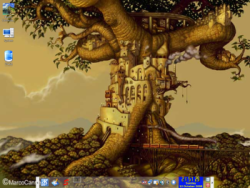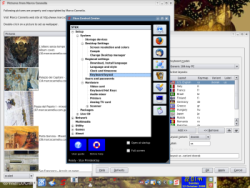Author: Preston St. Pierre
STUX 2.0, released last month, is a remarkable improvement from the 0.9.2 release I reviewed a couple years ago. While the look and feel of the Slackware-based distribution have stayed pretty much the same, STUX lacks the glaring technical problems that made it unusable on the previous occasion.
The STUX download comes in a CD image and a DVD image. I chose the latter, which weighs in at 4.1GB — clearly STUX has a lot of software to choose from. When burned to disc, the image is a live DVD with the option to install. One of the first things you see upon booting STUX is some beautiful background artwork. The artwork cycles and provides you with interesting new backgrounds every few minutes.
The install was a straightforward step-by-step process that anyone with a basic understanding of computers could follow. The most noteworthy part of the install is actually something it lacks: a place to set the root password. I assumed this meant that a default root password would still be in place on my installed system. While this wasn’t good, it probably wouldn’t hurt anything in the time it would take me to change it.
I rebooted the system with the DVD removed and loaded STUX from hard drive. Everything had seemed to work properly up until this point. Now, however, when I tried to log in to the default KDE desktop as the user “stux,” it appeared to work momentarily, then silently failed and kicked me back to the login screen. I tried logging in as root and adding a new user, but the new user was also unable to log in. After some looking around I discovered the problem: It appeared that my 10GB root partition was almost completely full; only a few megabytes of free space remained. After I removed some of the programs in the /opt directory the other users started working. Since I received no “disk is full” errors during the install, I suspect that, through some wicked twist of fate, my partition happened to be just big enough to hold the initial install and nothing more. I suppose it is possible that the installer silently failed and did not warn me about the disk being full, but I give STUX the benefit of the doubt in this situation.
All this time I had been using the password “root” when logging in as root. Quite by accident a typo showed me that, in fact, the root user had no password, and thus any password worked when attempting to log in. Having no root password is a big security no-no and one that is easy to solve. It wouldn’t stress the users to have to set a password for their system when installing it.
When I logged in as the user “stux” I found that keyboard layout I selected on the live CD (Dvorak) had been properly selected in KDE. This is one of those tiny features that may not matter to a lot of people but, after years of having to set it manually, really enhances my experience with a distribution. It doesn’t take a lot of code to implement this feature, but some developers simply don’t think about it.
A quick look around the Kicker menu showed me that pretty much everything but the kitchen sink is included on DVD and installed on the hard drive. A comprehensive listing of the 1,200-odd packages is available on the STUX Web site. You get Firefox for Web browsing, Azureus for BitTorrent, Kopete and Pidgin for instant messaging, Thunderbird and Seamonkey for email, XChat for IRC, gFTP for FTP, Amarok Audacious and JuK for music, Xine, MPlayer and VLC for video, the GIMP and Krita for graphics editing, OpenOffice.org and KOffice for office suites, and all the board games you could ever want to play. Any packages not included on the DVD can be installed through swaret, the Slackware package manager used by STUX.
I managed to get a few of my DVDs playing through MPlayer, though none of the other movie players would decode them. Some of my other DVDs would not play at all, though they have played on other Linux distributions under MPlayer. I mostly used Audacious for my music, but there were many other audio players to choose from that worked equally well. The codecs for most of my movies did seem to be installed, at least. Conspicuously lacking was the Flash plugin for Firefox, but that was an easy problem to fix. The Nvidia video drivers were included and installed by default, but Compiz had to be enabled in the STUX control panel, a program unique to STUX that allows users to edit various system configuration options and also contains simple wizards for some tasks (such as playing videos or music). For the most part, however, things just worked without any additional configuration.
STUX 2.0 has come far beyond the bug-ridden unusable system I encountered in my previous review. I would even recommend it to people looking for a new distribution to try, though with a hearty warning about setting a root password immediately after the install. The unique artwork adds a special touch to what is already a fine distribution, setting it apart from the ever-increasing crowd of good distributions.
Categories:
- STUX
- Reviews
- Linux
- Distributions




